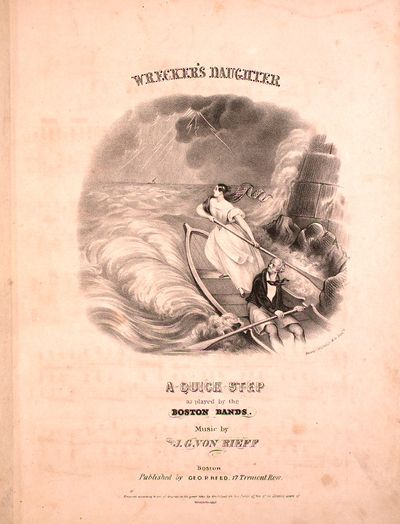Annotation:Wrecker's Daughter (1): Difference between revisions
No edit summary |
No edit summary |
||
| Line 10: | Line 10: | ||
<div style="text-align: justify; direction: ltr; margin-bottom: 90px; margin-left: 70px; margin-right: 120px;"> | <div style="text-align: justify; direction: ltr; margin-bottom: 90px; margin-left: 70px; margin-right: 120px;"> | ||
<br> | <br> | ||
'''WRECKER'S DAUGHTER.''' American | '''WRECKER'S DAUGHTER.''' American, Quickstep (2/4 time). D Major. Standard tuning (fiddle). AABBCC. The melody was originally German, composed by J.G Von Rieff (1771-1842), adapted by Conrad Fay. | ||
[[File:wreckers.jpg|400px|thumb|right|]] | [[File:wreckers.jpg|400px|thumb|right|]] | ||
The piece commemorates a 23 year woman, Grace Darling [https://en.wikipedia.org/wiki/Grace_Darling], who rescued nine people from the wreck of SS Forfarshire, which sank near the Farne Islands off the coast of Northumberland in 1831. It was was the inspiration for musical pieces, prose works and stage plays, as well as songs, and was popular with mid-19th century brass bands. Sheridan Knowles wrote a play called '''The Wreckers's Daughter''', staged at Drury Lane in 1836. | The piece commemorates a 23 year woman, Grace Darling [https://en.wikipedia.org/wiki/Grace_Darling], who rescued nine people from the wreck of SS Forfarshire, which sank near the Farne Islands off the coast of Northumberland in 1831. It was was the inspiration for musical pieces, prose works and stage plays, as well as songs, and was popular with mid-19th century brass bands (particularly as a solo by keyed bugle players). Sheridan Knowles wrote a play called '''The Wreckers's Daughter''', staged at Drury Lane in 1836. | ||
<br> | <br> | ||
</div> | </div> | ||
Revision as of 23:38, 4 August 2018
X:1 T:Wrecker's Daughter [1] M:2/4 L:1/8 R:Quick-Step B:Oliver Ditson – The Boston Collection of Instrumental Music (c. 1850, p. 100) Z:AK/Fiddler’s Companion K:D A/A/A/z/ A/A/A/z/|FA d2|dcBA|B/B/B/z/ B/B/B/z/|Bd g2| gfed|c/c/c/z/ c/c/c/z/|c/c/c/z/ c/c/c/z/|Ac/e/ a2|Ac/e/ a2| fedf|edce|d/d/d/z/ d/d/d/z/|d2 z2::eefe|ccdc| BBf>e|c>^G A/B/c/d/|eefe| ccdc|BBfe|A z a2:| |:(F2 A)d|(F2 A)d|(G2 B)d|(F2 A)d|(E2G)B|(A2 d)f| e^g/g/ gg|az a2|(F2 A)d|(F2 A)d|(G2B)d| (F2 A)d|(E2G)B|(A2d)f|eA/A/ Bc|d3 z!D.C.!:|]
WRECKER'S DAUGHTER. American, Quickstep (2/4 time). D Major. Standard tuning (fiddle). AABBCC. The melody was originally German, composed by J.G Von Rieff (1771-1842), adapted by Conrad Fay.

The piece commemorates a 23 year woman, Grace Darling [1], who rescued nine people from the wreck of SS Forfarshire, which sank near the Farne Islands off the coast of Northumberland in 1831. It was was the inspiration for musical pieces, prose works and stage plays, as well as songs, and was popular with mid-19th century brass bands (particularly as a solo by keyed bugle players). Sheridan Knowles wrote a play called The Wreckers's Daughter, staged at Drury Lane in 1836.
